
Evangelical Minister of Fordington for 51 Years
and Inventor of the Dry Earth Closet
Compiled by Michael Russell OPC for Fordington ©2007
Last updated February 2014

Rev Henry Moule
[Picture
by kind permission of the Dorset County Museum]
The Rev. Henry Moule (pronounced Mole) became Vicar of Fordington when he took over from the Rev John Palmer who had held the position for 30 years and died there aged 80 on the 11th May 1829. Henry was himself to remain Vicar for fifty one years until his death in 1880.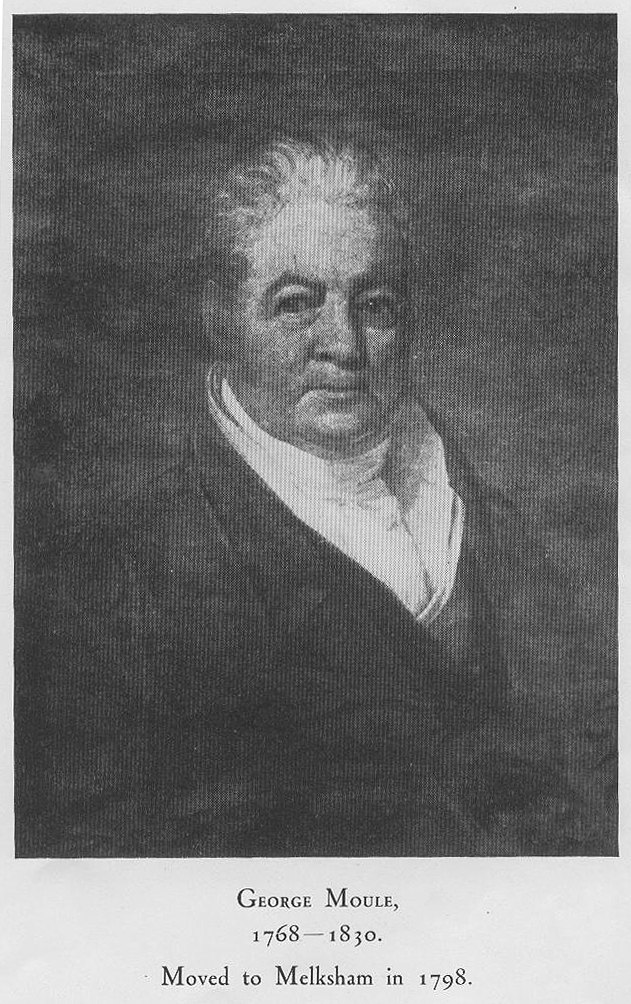  Henry was born in Melksham Wiltshire on 27th January 1801 the sixth son of twelve children of George Moule (1768-1830) and his wife Sarah Hayward (1764-1835). His immediate forefathers were in law or business in London but French in origin. His father, a solicitor and banker, had him educated at Marlborough grammar school, and in 1817 he went onto St John’s College at Cambridge(2) where he was elected a foundation scholar; obtaining a BA degree in 1821. At university he was greatly influenced by the Rev. Charles Simeon (1739-1836), the leader of the evangelical party of the church of England and Rector of Holy Trinity Church in Cambridge. Among other things he was one of the founders in 1797 of the Church Missionary Society (CMS), an organisation that was in later years to play a leading role in the lives of two of Henry's sons.
Henry was born in Melksham Wiltshire on 27th January 1801 the sixth son of twelve children of George Moule (1768-1830) and his wife Sarah Hayward (1764-1835). His immediate forefathers were in law or business in London but French in origin. His father, a solicitor and banker, had him educated at Marlborough grammar school, and in 1817 he went onto St John’s College at Cambridge(2) where he was elected a foundation scholar; obtaining a BA degree in 1821. At university he was greatly influenced by the Rev. Charles Simeon (1739-1836), the leader of the evangelical party of the church of England and Rector of Holy Trinity Church in Cambridge. Among other things he was one of the founders in 1797 of the Church Missionary Society (CMS), an organisation that was in later years to play a leading role in the lives of two of Henry's sons.The next few years were spent traveling in France and Switzerland as a tutor with the family of Admiral Sir W Hotham during the course of which he met a number of interesting people. Among them was John Kemble and a certain Mons. L'Ainy who had once been a general in the 'Grand Army' and who told him stories of Moreau's courage in battle. During their travels Henry spent a night in the Hospice of St Bernaud which straddles the highest point in the pass through the Alps. The hospice of St Bernard (4) was founded in 1047 and even then was famous for its St Bernaud dogs. At that time they would have been using the old Roman Road through the pass - the same one used by Napoleon in 1800 to march 40,000 men to defeat the Austrian Army. It is interesting that they chose this route from France into Switzerland as the original college of St John at Cambridge was dedicated to St Bernard in 1437 and provided for the education of Cistercian Monks. It was abolished during the dissolution of the monasteries and although Henry would have attended the new College erected in 1555 he had a daily reminder of its original dedication as a statue of St Bernard, a relic of the original college, sits above the gateway. On return to England he set out to make a career in the church and was ordained deacon at Salisbury on1st August 1824 (5), and then placed in the curacy of his home town of Melksham. It was in Melksham that he married on 1st July 1824 to Mary Mullett Evans, the second daughter of Joseph Jeffries Evans, a citizen and merchant of London, and his wife Mary Ann Mullett. Henry’s wife had been born on 17th September 1801 into a large pleasant house over her fathers offices in Staining Lane, close to St Paul’s. Her father Joseph Jeffries EVANS was a native of Bristol where his family had long been settled(11). He came from a long line of nonconformist ministers, of whom the last, his father, Dr Caleb Evans(12), was President of the Bristol Academy, and there had Robert Hall as a pupil and afterwards as coadjutor in his ministry. Dr. Evans was a man of fervent and gentle piety, and a writer of repute in his day. Her father J.J. Evans was a man of strong and cultivated mind, and though early removed by sudden death he was remembered to the last with ardent love by his children. Her mother Mary Ann Mullett was gifted with much mental activity and still more with the loveliest graces of unselfish kindness. After her husbands death she removed to Melksham in Wiltshire. Those who knew their daughter, Mary Mullett Evans, could trace both parents in her character - the fathers vigorous intelligence, and the Mothers various sympathies and tender heart. She went to good schools emerging with perfect handwriting and perfect English. If circumstances had led her that way she might have been an excellent literary critic and perhaps an original writer of some acclaim. The Evan’s family were of old Baptist stock originating from Brecon in Wales and Mary’s eldest brother a highly gifted individual, was articled to a London Solicitor along with one Benjamin D’Israeli. The young Disraeli traveled on the continent that year and carried to Heidelberg a letter announcing their marriage to some of Mary’s relatives. Gillingham 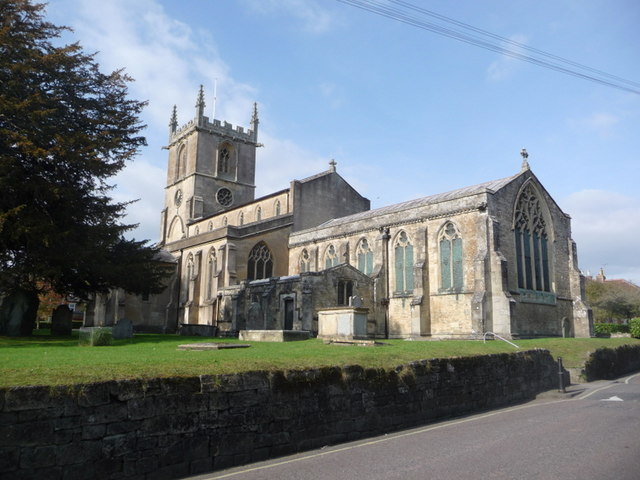 On 27 February 1825 Henry was ordained a priest by the bishop of Lincoln (following letters demissory from the bishop of Salisbury(2) ) and initially made curate of Melksham but 4 months later on 15th June, he was made a stipendiary Curate(5), and placed in sole charge of the church of St Mary the Virgin in the village of Gillingham in Dorset. Normally a curate would be an assistant to the Vicar of such a large parish, but in this case he was absent and the bishop showed great confidence in Henry's ability by placing him in charge, and in recognition of the heavy responsibility he gave him a larger than normal stipend of £150 pa. Even so on the 9th September that year Henry decided to supplement his income and advertised in the Times for four scholars that he could tutor in preparation for University. Only sixteen days after he placed his advertisement their first child, Henry Joseph Moule was born at the vicarage, and Henry duly baptised him in the church on the 14th of October 1825. His earnest work in the parish soon won the approval of Bishop Burgess of Salisbury, who came at his request to hold the first confirmation ever remembered at Gillingham. The following year he was awarded his Master of Arts degree and on 29th March 1828 Henry returned to Melksham as Officiating Minister to marry his sister Elizabeth Jane Moule who became the second wife of Colonel Christopher Sullivan Fagan (Vagan) of the Bengal Army(3 & 9). A second son duly arrived on 28th January 1828 who was baptised in St Mary's church on 14th April being named George Evans Moule after Henry's father and taking his mothers maiden name. In 1829 the vicar of Gillingham, Archdeacon Fisher, who was also patron of Fordington 'presented' Henry to that benefice. Memories of their period of pastoral work in the parish was tenderly remembered and cherished by Mary for the rest of her life. Arrival in Fordington In 1829 Henry was still a young man of 28 when he arrived in Fordington with his wife and two children to become the vicar of St Georges Church. He tackled the job with enthusiasm, making himself unpopular with the parishioners by introducing a second fiery sermon in the Sunday service, and reforming the music until he drove the choir away. At his first baptism, (the son of a Cordwainer called Job Allen and his wife Mary), he complained there was no water in the font; the Parish Clerk said of the previous parson, 'He never used no water; he did spit in his hand.' Many of his parishioners also disliked him being an enthusiastic evangelist and for a long time no one called at the Vicarage and worshipers were reviled at the churchyard gates as they passed through. We can gain an insight into his life at that time from the reminiscences of his youngest son, Handley who published them in 1914 in his book entitled. Memories of a Vicarage. He explained about his fathers arrival in the Parish:-
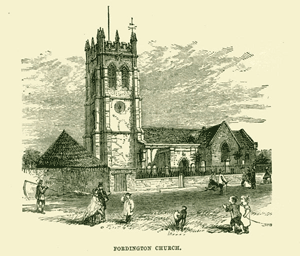
The events referred to here are the Swing Riots of 1830/31. Discontent at wages which had been reduced to below subsistence level by greedy landowners, finally boiled over in 1830. Riots which started in Kent, Surrey and Sussex spread rapidly into Hampshire and Dorset where field labourers expressed their anger by burning hayricks and smashing new steam driven machines. In December 1830 at Dorchester 55 men appeared before a special court & six were initially sentenced to death. Letters written by Mary in 1831, from the Vicarage to her relatives, and passed to Handley after her death, give further insight; talking of rick burning she refers to:-
In 1833 his protests to Lady Dorchester, a relative of William Pitts, put an end to the evils of the race meetings at Dorchester. The spectacle attracted large numbers of people to the area, many of a dubious moral character, and those left destitute often ended up in Fordington. Handley however also says about that time:-
All this activity gradually improved his standing in the Parish. This sketch of St Georges church shows how it was when he arrived and before it was extended to its present size. The Barracks & the Foundation of In 1829 Henry had also been appointed by the War Office as Chaplin to the troops in Dorchester Barracks (7), which is now partly occupied by the Dorset History Centre. The Parish of Fordington surrounds Dorchester on 3 sides and this was a time of rapid expansion with West Fordington forming a large suburb. In later years his son recalled:-
For many years he continued with his duties as Chaplin to the Soldiers and in 1845 he wrote a book called “Barrack Sermons”. This sold so well he was able to use the royalties to build a church for the troops in West Fordington, which he named 'Christchurch'. Many of these soldiers married locally and raised families in Dorchester, Fordington and the surrounding area. The Vicarage
Undeterred by disaffection, Henry ran the vicarage like a self-supporting commune, growing vegetables, running a hothouse and keeping cows. There was a personal tragedy for him and his wife when in 1839 his 7th son Christopher Cooper Moule died of atrophy when he was still only 15 months old. Throughout he continued earning extra money by teaching, and in 1841 he was not only tutoring his own six surviving children, but also eight paying boarders in the vicarage and adjoining house, something which he continued to do until 1859. We have the following description of the Vicarage from his son Handley's memory:- 'It is a rather long and rather low building, standing just off the road which runs from the east through Fordington into Dorchester. From the lower levels of the village the road climbs to a gentle hilltop where for the at least fifteen centuries the dead have been buried, and where the fine perpendicular tower of the parish church looks down upon the water meadows of the Frome river and the trembling blue line beyond of the Purbeck Hills. The village green bordered with houses lies close to the churchyard on the south. You walk on towards Dorchester for a few hundred yards and on your left hand a pair of stone steps leads up from the road to the sidewalk, and a door in a wall swings open, and you stand in the front garden of the house where I was born. Embedded in the wall of the house, close to the front door, is a tracery of a medieval window, discovered some sixty years ago by my father when he made certain changes in the structure; a sign that a priests house must have stood there already in the early fifteenth century. You enter, and find a dwelling seemly roomy of entire simplicity. The dinning room is spacious. as long as the depth of the house; otherwise the chambers are all of a modest scale. They look out, almost all, on the pleasant garden at the back, on lawn, paths, beds and embowering sycamores. The garden adjoins a field, once our field for cricket and other games, now used, I believe as a public playground'. 'The dear house itself - how shall i describe it? Each room was an individual friend. There was my mother's little parlor, the scene of my infant lessons at her side, and of her lifelong activities of intercourse, correspondence and a hundred works of love. My fathers study was next to it, a sacred room, where grave things in the service of God and man, little understood by the child, were done day by day by the busy pen and studious eyes, but where also we children spent many a happy hour. Then there was the Great Room. In any other house it would have been called the dinning room; but to us it was always 'the Study', because in the days of the pupils it was used as the chief classroom, between the hours of meals. (After the alterations done in 1850 he describes it as :-) It was lighted from both ends, warmed by two fireplaces, peopled with books in three of its four corners, and dignified at the lower end with a glorious arm-chair, fully episcopal in scale and style, which my brother henry, a born artificer, wrought out during his Cambridge vacations (1844-1848) as a tribute to his father, using some discarded oak from a recently rebuilt Dorchester Church for the purpose. Out of the Great room opened its counterpart, 'The Play room', used also for lessons, but much more as a place reserved for all the odds and ends of time. many a merry indoor game it witnessed, and I still hear the voices that joined in part-songs there on a winter evening, taught and led by my brother Horace, one of whose many gifts was music; at twelve years old he was already the 'little organist' in out parish church. Upstairs there were many rooms precious now to memory and first though remotest was the Nursery. In the nursery wall was a door, opening into 'the closet', a little dark chamber with many shelves full of multitudinous toys - articles most of them strong and durable long lived friends of those days. Close to the nursery was my mothers bedroom. and the long upstairs passage led to other rooms. In 1849 and 1854 Fordington was badly affected by outbreaks of Cholera. Although at first he was heartily disliked for his puritanical zeal, when the deadly cholera came Moule worked tirelessly with the sick and the dying, boiling or burning contaminated clothes and bedclothes, spreading help and sympathy. Handley his son later recalled:- “ Far more vividly I remember the autumn of 1854, when the cholera was upon us, and in tremendous force. A number of convicts had been drafted from London to the then vacant cavalry barracks and laundresses in Fordington took in the washing. The clothes had the disease lurking in them, and the awful mischief burst forth in the densely peopled and un-drained lanes of the town end of our village. My dear Father, with great courage and resource, “stood between the dead and the living”, and with the zealous help of the doctors (trained nurses hardly existed then) so dealt with the position that no case of infection occurred in the closely adjoining town. But our churchyard was peopled with dreadful rapidity; I remember six funerals in one day”. At this time he even gave up some of his church services and called people out into the fields for prayers, hymns, and preaching's under the trees. As a consequence of his endeavours Henry gradually won the respect of the whole community. He was convinced that the Cholera deaths were caused by appalling sanitation. Once, as he knelt by the bed of a dying man, the overflow from the one privy shared by 13 families trickled between him and the bed, and he saw the sewage bubbling up from the earth beneath the fireplace. What was needed was sanitary reform. The long, hot summer of 1858 highlighted the problem with the existing system of cesspools. Cholera, which was now known to be spread by contaminated water, was a constant problem and London became completely overwhelmed by its sewage when the streams through the city and feeding the Thames could no longer cope with the volume of effluent being produced. Coupled with an unusually warm summer that year the problem produced such a foul smell throughout the city that chemical soaked sacks had to be hung at the windows of the House of Commons and that year is now known as “The Great Stink of London”. In the summer of 1859 Henry decided his cess-pool was intolerable and a nuisance to his neighbour; so he filled it in and instructed his family to use buckets. At first he buried the sewage in trenches in the yard but discovered by accident that in 3 or 4 weeks no trace of the matter could be detected. So he erected a shed, sifted the dry earth beneath it, and mixed the contents of the bucket with dry earth every morning. “ the whole operation does not take a boy more than a quarter of an hour and within ten minutes after its completion neither the eye nor the nose can detect anything offensive”. Then he discovered that he could recycle the earth and use the same batch several times and use the contents to beneficial effect in the garden. He persuaded a farmer to fertilise one half of a field with earth used five times in his closet and another with equal weight of superphosphate. Swedes were planted in both halves and those nurtured in earth manure grew one third bigger.Dry Earth System Patent (8) 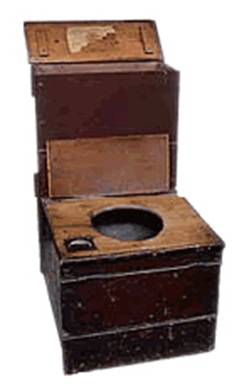 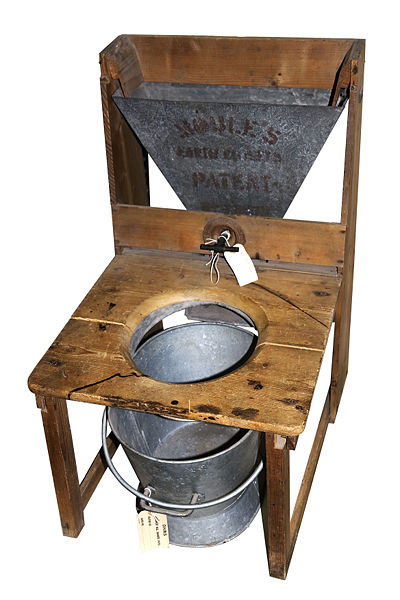
Far
more important Moule believed that if this system could be adopted widely
it would go a long way towards preventing the spread of disease, thereby
leading to a general improvement of everybody’s health. He produced
a sort of commode with a bucket below the seat and a hopper behind it
containing dry earth or ashes. When you had finished you pulled a lever
to release a measured amount of earth into the bucket and cover its contents.
On 28th May 1860 in partnership with James Bannehr he took out a patent for the dry earth system
(No.1316) and further patents in 1869 and 1873. He published many works bearing on this subject the first being "Advantages of the Dry Earth Sytem" in 1868 and he set up the 'Moule Patent Earth
Closet Co. Ltd' which manufactured and sold earth closets. The picture on the right shows the improved version of 1875. Moule spent the rest of his life advocating its adoption and he managed to convince a lot of people. In 1865 the Dorset County School in Dorchester with 83 boys adopted the system cutting the annual maintenance costs and eliminating smells and diarrhoea. The Indian Government in particular established the system in its hospitals, lunatic asylums and gaols and commissioned a report following trials in Bengal; the Punjab and North Western Provinces. They were so satisfied with the results that they awarded him a payment of £500, a considerable sum in those days. He took the step of publishing extracts from the report and letters to him from the Indian Government in the Times on 14th November 1867. In 1868 the Lancet reported that 148 of his dry earth closets were used at the Army volunteer encampment at Wimbledon – forty or fifty of them used daily by not less than 2000 men, “without the slightest annoyance to sight or smell”. 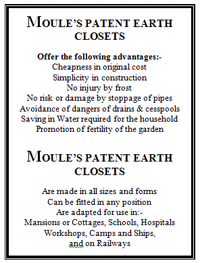
Mary Mullett Moule (1801-1877) For many years Mary’s main role had been the rearing of her children, and overseeing of domestic arrangements for a household often exceeding 16, but by 1859 when they gave up paying pupils and Henry started filling in his cess pool, she was free to devote herself more to the service of the Parish. She had already been the devoted superintendent of the girls Sunday School and a friend of every teacher and pupil. Now she embarked upon an incessant domestic visitation programme during the course of which she came to know not only every house but well-nigh every room in the Parish. No weather, however wet , windy, or cold ever interfered with the literally daily round. One woman said to Handley of her “ Her feet brought light into the room”. Mary who had lived to be the last survivor of her father's numerous family, suddenly had a stroke on 29 June 1877 from which she was paralysed and during the next 8 weeks she never spoke again before she passed away on 21st August. She was buried 3 days later in St George's churchyard & the Teachers of the Sunday School she had befriended for nearly 50 years paid for a wall plaque to be erected inside the church to her memory. Shortly after her death in 1877 her sons had published by Henry Ling the printer in County House Dorchester a small book about her life entitled "The Memory of the Just is Blessed" a brief memorial of Mrs Moule of Fordington. The power of the internet never ceases to amaze me as I was very fortunate to be able to recover an original copy of this now rare publication from a dealer in antique books based in of all places Mallorca Spain.
from a photograph taken by him in the year 1869 which remained an admirable likeness up to the last
The Children of Henry Moule and Mary Mullett Evans Henry & Mary had 8 sons in all as listed below. Henry Joseph was 4 years old, and his brother George just 1 when the family arrived in Fordington in 1829. All the others were born at the Vicarage in Fordington. In addition to these children they adopted a 4 year old nephew of Mary's. Her younger brother Robert Mullett Evans a Clerk in the Customs House who lived in Hackney, died on 25th July 1846. His wife Matilda Katherine Flyn had pre deceased him on 20th Feb that year, so this left their son a small boy called Matthew Flyn Evans (born in 1843 at Kingsland Middlesex) an orphan. He was temporarily sent to Bristol to his mothers family but Mary being a devout Christian immediately stepped into the breach and had him brought by coach from Bristol to Fordington and raised him alongside the youngest of their children as one of their own. Matthew went on to study at St John's Hall College in Islington (originally called Highbury College of Divinity) and then served as curate at St Georges church in Fordington from 1872 to 1878. He married a British Subject from America called Mary Georgina Allardyce in 1879. After serving as curate at the church of St Nicholas in Sittingborne he was made rector of Thanington where he died there on 18th January 1917. Matthew is depicted in the family picture given below taken in 1869. Henry Joseph Moule [1825 - 1904] Water Colour Artist George Evans Moule [1828 - 1912] Missionary and Bishop of Mid China Frederick John Moule [1830 - 1900] Vicar of St Peters Church - Yaxley Horatio Mosley Moule [1832 - 1873] Friend of Thomas Hardy Charles Walter Moule [1834 - 1921] Classical Lecturer & Tutor at Cambridge Arthur Evans Moule [1836 - 1916] Missionary & Archdeacon of Mid China Christopher Cooper Moule [1838 - 1839] [Died an Infant] Handley Carr Glyn Moule [1841 - 1920] Bishop of Durham Reverend Henry Moule and family on Fordington Vicarage lawn 5th Aug 1869
Identification Standing (left to right): Arthur Evans Moule; Eliza Agnes (wife of Arthur); Henry Joseph Moule; Elizabeth (wife of Henry); Mathew Evans (Curate of Fordington and Nephew); Handley Carr Glyn Moule: Charles Walter Moule; Horatio Mosley Moule; George Evans Moule; Adelaide Sarah (wife of George); Frederick John Moule; Mary Alicia (wife of Frederick) Seated: Rev Henry Moule; Mary Mullett Moule (wife of Henry): Source 'History of The Moule Family website' where other pictures of the family may be viewed Moule family connection with Thomas Hardy [1840-1928] It is not quite clear how Thomas Hardy got to know the Moule family, nor which member he knew first. It was probably the eldest son Henry Joseph with whom he remained a close friend for fifty years. Although Hardy was also friendly with George and Charles, it was Horatio Mosley Moule [known as Horace] whom Hardy met in 1857 who had the greatest influence on him. Henry Moule died just short of his 80th birthday at Fordington on Tuesday 3rd February 1880 and was similarly honoured. They are buried together in the foremost grave in St George’s churchyard. |
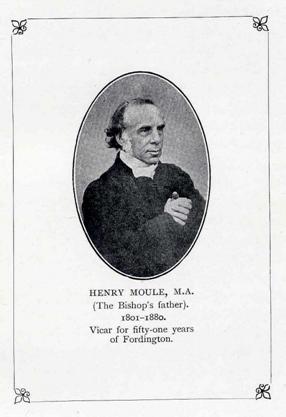 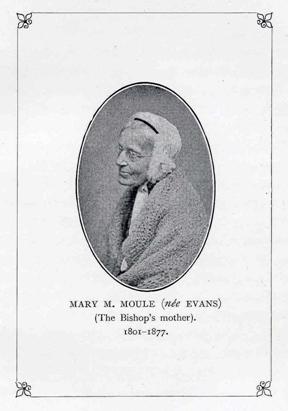 Portraits taken In Later Years: Link to Monumental Inscriptions in St Georges Church Publications Throughout his life Henry wrote many books and particularly pamphlets on religious and educational topics as well as volumes of poetry. I have located the following at the British Library which include some publications issued after his death in 1880 (system reference numbers added after the title). Unfortunately I do not have the time or resources to order and view them:-
Scraps of Sacred Verse 014616928 (1846); 'Barrack Sermons' preached at Dorchester 002568101 (1847); Four Letters to ... Prince Albert ... on the Dwellings and Condition of ... the Working Classes and Poor of Fordington 002568104 (1854) Eight letters to Prince Albert as President of the Council of the Duchy of Cornwall 002568103 (1855) Scriptural Church Teaching 002568127 (1848); Tempora mutantur. A Memorial of the Fordington Times Society.001268769 (1859) My Kitchen Garden by a Country Parson 001978398 (1860); Manure for the Million; A Letter to the Cottage Gardeners of England 002568113 (1861); Self-supporting Boarding Schools and Day Schools for the children of the industrial classes 002568129 (1856) & 002568130 (1862) Good out of Evil. A series of letters 002568105 (1863) Hope against Hope. Illustrated in the case of the Convict E. Preedy, who was hanged for murder at Dorchester, March 27, 1863. 002568107 (1863) Pardon and Peace. Illustrated by a few brief ministerial memorials, to which are added some pieces of sacred verse 002568121 (1865) Supplemental Hymns of Adoration and Praise 002568132 (1865); Earth sewage versus water sewage, or, National health and wealth instead of disease and waste 007937116 (1868); La terre se'che substitue'e a' l'eau dans le curage des fosses d'aisances ou Salubrite' et richesse publiques remplac,ant la maladie et la de'perdition (1868); Narrative of the conversion of a Chinese Physician 002568133 (1868); Our Home Heathen: how can the Church of England get at them? 002568119 (1868) More than one universal Deluge recorded in the Scriptures. A paper read at a Meeting of the Victoria Institute,002568114 May 3, (1869) Land for the Million to Rent Addressed to the Working Classes of England 002568110 (1870); The Science of Manure as the Food of Plants, etc 002568125 (1870) The Impossibility Overcome: or, the inoffensive, safe, and economical disposal of the refuse of towns and villages, etc 002568108 (1870) Self-supporting Boarding Schools and Day Schools for the children of the industrial classes. Two papers, read before the Southern Counties Adult Education Society 002568131 (1871) National Educational expenses: how to a large extent these may be met 002568115 (1871); The Dry Earth System. The advantages of the Dry Earth System in the disposal of sewage and excreta 002568102 (1871) Israel in Egypt: the period of their sojourn and their numbers at the Exodus 002568109 ... A paper read ... June 5, (1871) The Potato Disease: its cause and remedy. "Three Letters to the Times." 002568123 (1872); Town Refuse the remedy for Local Taxation 002568135 On the Testimony of a portion of the vegetable creation to the God of the Scriptures. A paper read at a meeting of the Victoria Institute,002568117 March 17,(1873); Scripture Interpreted on Scripture Principles 002568128 (1874); The Relation of Jew and Gentile in God's eternal purpose. 002568124 June 11th and 12th, (1874); National Health and Wealth promoted by the general adoption of the dry earth system, 002568116 (1875) The "Moule-and-With" Manures and the "With" Compound 001660428 (1877) Harvest Hymns 002568106 (1877) To the Worshipful the Mayor and the Town Council of the Borough of Dorchester. [On a scheme for the drainage of Dorchester.] 002568134 (1879); "Doctrine, Manner of Life, Purpose." Sermons preached ... on occasion of the death of ... Henry Moule ... By three of his sons [H. C. G. Moule, G. E. Moule, and A. E. Moule] (1880) Light at Evening Time: a story of conversion ... Edited with a preface by .. Handley C. G. Moule, D.D., Bishop of Durham 002568111 (1908) Paupers, criminals and cholera at Dorchester in 1854 : being letters from Henry Moule to H.R.H. the Prince Consort during the cholera of 1854010309945 (1968) (1). Memories of a Vicarage by Handley C.G.Moule published by The Religious Tract Society 1914 of which I own an original copy. (2). Cambridge University Alumni, 1261-1900 [database on-line]. Provo, UT, USA: The Generations Network, Inc., 1999. Original data: Venn, J. A., comp.. Alumni Cantabrigienses. London, England: Cambridge University Press, 1922-1954 - sizar at St John's July 3rd 1817. Matriculated Michs 1817; Scholar 1817; BA 1821; MA 1828; Ordained deacon (Salisbury) Aug 1st 1824; Priest (Lincoln Litt dim frim Salisbury) Feb 27 1825 (3). Church of latter Day Saints International Genealogical Index (IGI) extraction programme (do not confuse with a member entry) (4). Link to more information about the Hospice of St Bernard (5). Clergy of the Church of England database (6). Fordington St Georges church Parish Registers (7). This is a link to the Ordnance Survey map of Fordington for the year 1890 on the "British History on Line" website. Because I have selected a higher magnification and specific point in the map it takes rather a long time to load. Once loaded however just click on the edge of map in the direction you wish it to move and you can travel around Fordington at will. As you enter you will see the Infantry barracks housing the Dorset History Center and running diagonally to the north "Poundbury road" with the "Royal Horse Artillery Barracks" on the other side as well as the location of the church Henry Moule funded and built called "Christchurch". (8). Times Newspaper contains numerous advertisements, papers, comments etc about the Dry Earth Closets as well as articles about its success etc in places like India (9). The first wife of Colonel Christopher Sullivan Fagan, is recorded on the IGI by a member as being Agnes Baldock of Guernsey,whom he married circa 1809 and is said to have died about 1826. (10). 'The Memory of the Just is Blessed' A brief memorial of Mrs Moule of Fordington published at Dorchester by Henry Ling a machine printer at County House Dorchester in 1877 and written by her sons ANCESTRY of MARY MULLET EVANS (1801-1877) (11). Mary Mullett EVANS (1801-1877) was the daughter and 3rd child from the marriage of her father Joseph Jefferies EVANS (1768-1812) a Merchant of London to Mary Anne MULLETT (still a minor at marriage) the daughter of Thomas & Mary MULLETT who married by licence at St Botolph without Bishopsgate on 23rd Feb 1796. Her father Joseph was the 4th child of a Baptist Minister Dr Caleb EVANS (See Genealogical note 12 below). Joseph & Mary had the following children before Joseph died at St Mary Axe in London leaving a will dated 16th April 1812 which was proved by his widow Mary Anne on 3rd Feb 1813. He was buried in the non-conformist cemetery at Bunhill Fields on 31st Dec 1812. His widow Mary Anne then moved to live at Shaw near Melksham.
(11.2) Thomas Mullett Evans (b.1799- 1834) Born at Staining Lane City of London in the parish of St John Zachary on 10th June 1799 his birth was registered at Dr Williams Library 3rd July 1799. A highly gifted individual, he was articled on 2nd April 1816 to a London Solicitor, William Stevens, to serve him in the profession of Attorney at Law and Solicitor in Chancery for the term of 5 years. His articles were witnessed by Sarah Jefferies Evans and Charles Thomas Moule. He was solicitors clerk at the City firm of Swaine and Stevens with Benjamin Disraeli and together they invested in Latin American mining shares losing all their money in the market collapse of 1825. Undaunted and now a qualified Attorney, Thomas married Mary Biggs at St Marys Lambeth on 22nd June 1826 and moved to Bristol as a partner in the Solicitors of Ball and Evans. They lived in Bristol at 26 Clare Street. He left a will dated 16th April 1832 and was buried at Bristol on 8th May 1834, his will being proved by his mother and executor Mary Anne Evans on 30th December 1834. Apart from his wife his will also names his brother Frederick. (11.3) Mary Mullett Evans(1801-1877) Born at Staining Lane City of London in the parish of St John Zachary on 17th Sep 1801 her birth was registered at Dr Williams Library 13th Oct 1801. The wife of Rev Henry Moule of Fordington the subject of this biography. (11.4) Frederick Mullett Evans (b.1804-1870) Born at Staining Lane City of London in the parish of St John Zachary on 29th Jan 1804 his birth was registered at Dr Williams Library 5th April 1804. A master printer by trade he married Maria MOULE (1807-1850) the younger sister of the Rev Henry Moule. She had been baptised at Melksham on 21st August 1807 and married Frederick there on 21st Oct 1830. The same year Frederick joined with William Bradbury (1800-1869) to found the printing firm of Bradbury and Evans located in Bouverie Street and Lombard Street Whitefriars. In December 1842 Bradbury and Evans became proprietors of the struggling new comic magazine 'Punch'. Much more background is given to his career in the Dictionary of National Biography. They raised a large family before Maria died at the age of 42 in Church Row, Stoke Newington Hackney being buried at St Marys Church on 1st March 1850. By 1851 Frederick was in Ramsgate running a substantial business employing over 300 people. It continued to prosper and the 1861 census shows him resident at 19 Queens Road St Pancras and employing between 400 and 500 men. In the same year their daughter Elizabeth Matilda Moule Evans married Charles Dickins junior the son of the famous author whose full name was Charles Culliford Boz Dickens. Frederick died at the age of 66 being buried at St marys Stoke Newington with his wife on 25th June 1870. (11.5) Robert Mullet Evans (b.1806) Born at Old Bethlem in the Parish of St Botolph Bishopsgate London on 13th Nov 1806. His birth was registered at Dr Williams Library on 9th Dec 1806. Indentured 28th May 1827 to George Moule of Melksham gent Attorney at Law of Kings bench (11.6) Hugh Caleb Evans (b.1809) Born at Old Bethlem in the Parish of St Botolph Bishopsgate London on 14th Dec 1808. His birth was registered at Dr Williams Library on 22nd Feb 1808. He became a printer and bookseller by trade and was living with his widowed mother at 9 upper Berkeley place in Bristol in 1851 when he was still a bachelor. (11.7) Charles Mullett Evans (b.1811) Born in the parish of St Andrew Undershaft in London his birth was registered at Dr Williams Library on 25th March 1811. His publications procured him a considerable reputation as a divine and scholar and he received two honary doctorates, one from Rhode Island College (1789) and the other from Kings College in Aberdeen (1790). He died of a paralytic affection on 9th August 1791. Her grandfather had married twice first at St Andrews Church in Pershore Worcester on 19th April 1762 to Miss Sarah JEFFRIES (d.1771) (the only daughter of the Rev. Joseph JEFFRIES of Taunton in Somerset and his 2nd wife Miss Rickard) by whom he had five children:-
(12.2) Hugh Evans (b.1766) bap Bristol 5th Oct 1766 (12.3) Elizabeth Evans (b.1770) bap Bristol 27th Jan 1770 (12.4) Joseph Jeffries Evans (1768-1812)) bap Bristol 7th March 1768 - her father see above (12.5) Benjamin Jeffries Evans (b.1771) bap Bristol 3rd Sep 1771 (13) Mary Mullett EVANS (1801-1877) her great grandfather was Rev. Hugh EVANS MA (1712-1781) also Baptist Minister at Broadmead before her grandfather and Principal of the Bristol Baptist Academy. He and his wife Sarah BROWN (d.1751), who was the daughter of Joseph BROWN of Bristol, had the following children:-
(13.2) Caleb Evans (1737-1791) Bap Broadmead Baptist church Bristol 20th Nov 1737 - her grandfather see above (13.3) Elizabeth Evans (b.1736) Bap Bristol 25th Dec 1739 (13.4) Hannah Evans (b.1741) Bap Bristol 18th May 1741 (13.5) Mary Evans (b.1743) Bap Bristol 11 Oct 1743 (13.6) Ann Ward Evans (b.1748) Bap Bristol 21 Jan 1748 Sources:- Chambers Biographical Dictionary; Broadmead Non Conformist Parish registers RG4 series eg piece 3766; International Genealogical index RG4/3766; CLDS Film 350563; DNB with its own source list; Parish Marriage Register for London Bishopsgate St Botolph without . |